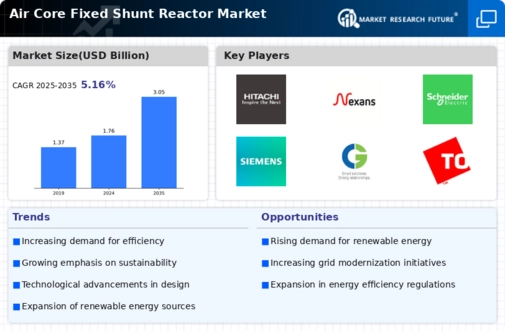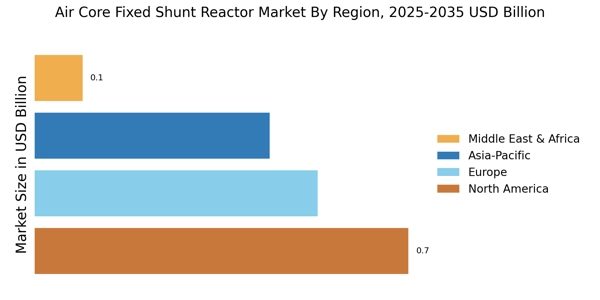Growing Focus on Grid Modernization
The Air Core Fixed Shunt Reactor Market is experiencing growth driven by a growing focus on grid modernization. As aging infrastructure poses challenges to energy delivery, utilities are increasingly investing in upgrading their systems to enhance reliability and efficiency. Modern grids require advanced reactive power solutions to manage the complexities introduced by distributed energy resources. The integration of air core fixed shunt reactors is becoming a preferred choice for utilities aiming to improve voltage regulation and reduce losses. Market analysis indicates that the grid modernization initiatives could lead to a market growth rate of approximately 7% in the coming years. This trend underscores the importance of the Air Core Fixed Shunt Reactor Market in supporting the transition to smarter, more resilient energy systems.
Regulatory Support for Energy Efficiency
The Air Core Fixed Shunt Reactor Market is benefiting from increasing regulatory support aimed at enhancing energy efficiency. Governments worldwide are implementing stringent regulations to reduce energy losses and promote sustainable practices in power generation and distribution. These regulations often mandate the use of reactive power compensation devices, including air core fixed shunt reactors, to optimize grid performance. For instance, policies encouraging the adoption of energy-efficient technologies are likely to drive market growth, with projections indicating a potential increase in market size by 10% over the next few years. This regulatory environment not only fosters innovation but also encourages investments in the Air Core Fixed Shunt Reactor Market, as stakeholders seek to comply with evolving standards and improve operational efficiency.
Technological Advancements in Power Systems
The Air Core Fixed Shunt Reactor Market is experiencing a notable transformation due to rapid technological advancements. Innovations in materials and design are enhancing the efficiency and reliability of shunt reactors. For instance, the introduction of advanced insulation materials is improving performance under high voltage conditions. Furthermore, the integration of smart grid technologies is facilitating better monitoring and control of reactive power, which is essential for maintaining voltage stability in power systems. As a result, the market is projected to grow at a compound annual growth rate of approximately 5% over the next five years, driven by these technological improvements. This trend indicates a shift towards more efficient and sustainable energy solutions, positioning the Air Core Fixed Shunt Reactor Market favorably in the evolving energy landscape.
Increasing Demand for Reactive Power Compensation
The Air Core Fixed Shunt Reactor Market is witnessing a surge in demand for reactive power compensation solutions. As electrical grids become more complex and interconnected, the need for maintaining voltage levels and improving power quality is paramount. Shunt reactors play a crucial role in mitigating voltage fluctuations and enhancing system stability. According to recent data, the demand for reactive power compensation devices is expected to rise by 6% annually, reflecting the growing emphasis on grid reliability. This trend is particularly evident in regions with high penetration of renewable energy sources, where fluctuations in generation necessitate robust reactive power management. Consequently, the Air Core Fixed Shunt Reactor Market is poised for growth as utilities and energy providers seek effective solutions to address these challenges.
Rising Investments in Renewable Energy Infrastructure
The Air Core Fixed Shunt Reactor Market is poised for expansion due to rising investments in renewable energy infrastructure. As countries strive to transition towards cleaner energy sources, significant capital is being allocated to develop wind, solar, and hydroelectric projects. These renewable energy systems often require effective reactive power management to ensure stability and reliability. Consequently, the demand for air core fixed shunt reactors is expected to increase, as they provide essential support in maintaining voltage levels and enhancing grid performance. Recent estimates suggest that investments in renewable energy infrastructure could reach trillions of dollars over the next decade, thereby creating substantial opportunities for the Air Core Fixed Shunt Reactor Market to thrive in this evolving landscape.


















Leave a Comment